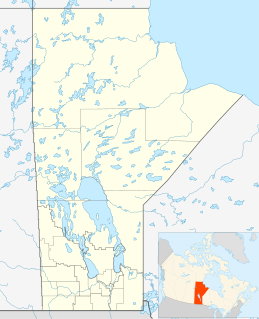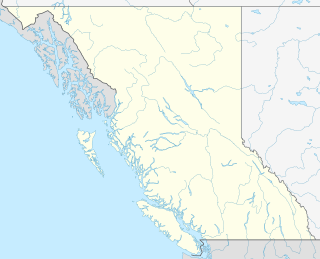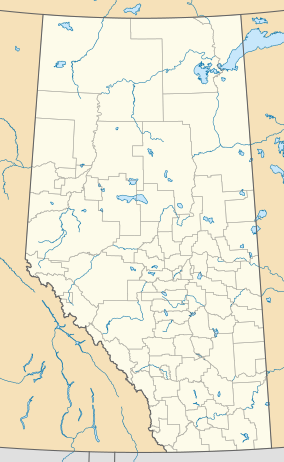
The Athabasca River is a river in Alberta, Canada, which originates at the Columbia Icefield in Jasper National Park and flows more than 1,231 km (765 mi) before emptying into Lake Athabasca. Much of the land along its banks is protected in national and provincial parks, and the river is designated a Canadian Heritage River for its historical and cultural importance. The scenic Athabasca Falls is located about 30 km (19 mi) upstream from Jasper.

Wood Buffalo National Park is the largest national park of Canada at 44,807 km2 (17,300 sq mi). It is located in northeastern Alberta and the southern Northwest Territories. Larger in area than Switzerland, it is the second-largest national park in the world. The park was established in 1922 to protect the world's largest herd of free roaming wood bison. They became hybridized after the introduction of plains bison. The population is currently estimated at more than 5,000. It is one of two known nesting sites of whooping cranes.

Kananaskis Country is a multi-use recreation area situated to the west of Calgary, Alberta, Canada, in the foothills and front ranges of the Canadian Rockies. The area is named for the Kananaskis River, which was named by John Palliser in 1858 after a Cree acquaintance.

Willmore Wilderness Park, located in Alberta, Canada, is a 4,600 square kilometres (1,800 sq mi) wilderness area adjacent to the world-famous Jasper National Park. It is lesser known and less visited than Jasper National Park. There are no public roads, bridges or buildings. There are, however, several ranger cabins in the park that are available as a courtesy to visitors.

The Peace River is a 1,923-kilometre-long (1,195 mi) river in Canada that originates in the Rocky Mountains of northern British Columbia and flows to the northeast through northern Alberta. The Peace River joins the Athabasca River in the Peace-Athabasca Delta to form the Slave River, a tributary of the Mackenzie River. The Finlay River, the main headwater of the Peace River, is regarded as the ultimate source of the Mackenzie River. The combined Finlay–Peace–Slave–Mackenzie river system is the 13th longest river system in the world.
The Canadian Parks and Wilderness Society (CPAWS) was founded in 1963 to help protect Canada's wilderness.

Bow Valley Provincial Park is a provincial park in Alberta, Canada. Established in 1959 in the arch of the Bow River at its confluence with the Kananaskis River, the park is one park of many within the Kananaskis Country park system.

Atikaki Provincial Park is a wilderness park in Manitoba, Canada located east of Lake Winnipeg along the Ontario boundary in the Canadian Shield. The area of Atikaki Provincial Park is 3,981 km2. Atikaki Provincial Park is north of Nopiming Provincial Park and borders the Woodland Caribou Provincial Park in Ontario.

Tweedsmuir North Provincial Park and Protected Area is a provincial park in British Columbia, Canada, which along with Tweedsmuir South Provincial Park and Entiako Provincial Park were once part of Tweedsmuir Provincial Park, then B. C.'s largest park, 9,810 square kilometres (3,790 sq mi) located in the Coast Range.

Alberta has been a tourist destination since the early days of the 20th Century, with attractions including national parks, National Historic Sites of Canada, urban arts and cultural facilities, outdoor locales for skiing, hiking and camping, shopping locales such as West Edmonton Mall, outdoor festivals, professional athletic events, international sporting competitions such as the Commonwealth Games and Olympic Winter Games, as well as more eclectic attractions.

Spray Valley Provincial Park is a provincial park located east of the Rocky Mountains, along the Spray River in western Alberta, Canada.

Chinchaga is a river in north-western Alberta. It is a tributary of the Hay River. Through the Hay River, its waters are carried to the Arctic Ocean via Great Slave Lake and Mackenzie River. The name Chinchaga is First Nations, and means "Big Wood River". Much of the Chinchaga watershed burned in 1950 during the Chinchaga fire.

Chinchaga Wildland Park is a protected 800 km2 (310 sq mi) tract of land in the 5,000 km2 (1,900 sq mi) of the greater Chinchaga wilderness area in a disjunct outlier of the Foothills Natural Region of Alberta, in a remote area of northwest Alberta, Canada, about 140 kilometres (87 mi) west of Manning. It was designated as a Wildlife Park in December 1999. The greater Chinchaga area was identified in 1995 as an Environmentally Significant Area. It was designated by the Alberta Government as a protected area in 2000, under the "Special Places" program. "Elevations in the Park range from 650 m adjacent to the Chinchaga River to 915 m at the height of land atop Halverson Ridge."

The Caribou Mountains are a mountain range in northern Alberta, Canada, surrounding a saucer-shaped elevated plateau that rises 700 m (2,300 ft) above the surrounding lowlands. The Caribou Mountains reach an elevation of up to 1,030 m (3,380 ft), making them the highest in northern Alberta. They rise north of the lower Peace River and are bounded to the north and east by Wood Buffalo National Park. The area was unglaciated during the last glacial period.

The Ghost River Wilderness Area is a provincially designated wilderness area in the Canadian Rockies of Alberta protecting the headwaters of the Ghost River. It was established in 1967 and it, as one of the three Wilderness Areas of Alberta, has the strictest form of government protection available in Canada. All development is forbidden and only travel by foot is permitted. Hunting and fishing are not allowed. The other two Wilderness Areas are White Goat Wilderness Area and Siffleur Wilderness Area and together the three areas total 249,548.80 acres (100,988.82 ha).

Northern Alberta is a geographic region located in the Canadian province of Alberta.

The White Goat Wilderness Area is a provincially designated wilderness area in the Canadian Rockies of Alberta. It was established in 1961 and it, as one of the three wilderness areas of Alberta, has the strictest form of government protection available in Canada. All development is forbidden and only travel by foot is permitted. Hunting and fishing are not allowed. The other two wilderness areas are Ghost River Wilderness Area and Siffleur Wilderness Area and together the three areas total 249,548.80 acres (100,988.82 ha).

The Siffleur Wilderness Area is a provincially designated wilderness area in the Canadian Rockies of Alberta. It was established in 1961 and it, as one of the three wilderness areas of Alberta, has the strictest form of government protection available in Canada. All development is forbidden and only travel by foot is permitted. Hunting and fishing are not allowed. The other two wilderness areas are White Goat Wilderness Area and Ghost River Wilderness Area and together the three areas total 249,548.80 acres (100,988.82 ha).

Kazan Wildland Park is a wildland provincial park in northern Alberta, Canada that is 570,955 ha in size. It is located in the far northeast corner of the province within the Regional Municipality of Wood Buffalo, encompassing the majority of lands north of Lake Athabasca and east of the Slave River and Rivière des Rochers adjacent to Wood Buffalo National Park. The Government of Alberta announced its creation through its approval of the Lower Athabasca Regional Plan in August 2012.


















